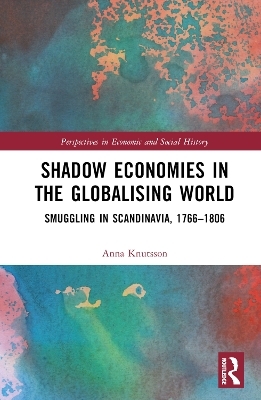
Shadow Economies in the Globalising World
Smuggling in Scandinavia, 1766–1806
Seiten
2022
Routledge (Verlag)
978-1-032-12740-8 (ISBN)
Routledge (Verlag)
978-1-032-12740-8 (ISBN)
This book explores how and why various global wares ended up in Scandinavian borderlands during the eighteenth-century, and analyses what smuggling can reveal about the emergence of global trade, the formation of the nation state, and the development of consumer society in Europe’s northernmost outskirts.
From West Indian sugar and bottles of Southeast Asian arrack to French red wines, English felt cloth, and Mediterranean lemons, many global wares ended up in the Scandinavian borderlands during the late eighteenth century. This book explores how and why these goods came to be there and analyses what smuggling can reveal about the emergence of global trade, the formation of the nation state, and the development of consumer society in Europe’s northernmost outskirts.
This book shows that the global underground was ubiquitous in the Nordic countries and fundamentally altered them, politically, economically, socially, and culturally. Through re-evaluating the role of smuggling the book complements and challenges established historical accounts about state building, market dynamics, consumer culture, and ideas and identity. It also offers a roadmap for how to think about illegal global trade and how to approach this notoriously difficult research field. By integrating illegality, the book aims to show how an illicit web entangled often overlooked ‘peripheral’ territories with traditional ‘portals of globalisation’ and proposes a novel take on early modern globalisation and the paths to modernity in the European hinterlands. To achieve this a wide variety of sources are used including court records, administrative sources, diaries, ambassadorial correspondence, and maps in various languages including Swedish, Finnish, Norwegian, English, and French.
This book makes a significant contribution to the literature on economic history, the first wave of globalisation, the study of shadow economies, and Scandinavian history more broadly.
From West Indian sugar and bottles of Southeast Asian arrack to French red wines, English felt cloth, and Mediterranean lemons, many global wares ended up in the Scandinavian borderlands during the late eighteenth century. This book explores how and why these goods came to be there and analyses what smuggling can reveal about the emergence of global trade, the formation of the nation state, and the development of consumer society in Europe’s northernmost outskirts.
This book shows that the global underground was ubiquitous in the Nordic countries and fundamentally altered them, politically, economically, socially, and culturally. Through re-evaluating the role of smuggling the book complements and challenges established historical accounts about state building, market dynamics, consumer culture, and ideas and identity. It also offers a roadmap for how to think about illegal global trade and how to approach this notoriously difficult research field. By integrating illegality, the book aims to show how an illicit web entangled often overlooked ‘peripheral’ territories with traditional ‘portals of globalisation’ and proposes a novel take on early modern globalisation and the paths to modernity in the European hinterlands. To achieve this a wide variety of sources are used including court records, administrative sources, diaries, ambassadorial correspondence, and maps in various languages including Swedish, Finnish, Norwegian, English, and French.
This book makes a significant contribution to the literature on economic history, the first wave of globalisation, the study of shadow economies, and Scandinavian history more broadly.
Anna Knutsson graduated with a PhD in history at the European University Institute in 2019 after writing a thesis about smuggling in Sweden during the eighteenth century. Since then, she has taken up an international postdoctoral fellowship at Uppsala University, Cambridge University, and NTNU and is currently researching illegal trade and its impact on northern European peripheries.
1. Introduction 2. Trade in Conflict 3. Porous Borders 4. Racketeering Retailers 5. Consuming Contraband: Worsteds & Coffee 6. Smuggling and the Perpetual War 7. Conclusion
| Erscheinungsdatum | 12.12.2022 |
|---|---|
| Reihe/Serie | Perspectives in Economic and Social History |
| Zusatzinfo | 2 Tables, black and white; 16 Halftones, black and white; 16 Illustrations, black and white |
| Verlagsort | London |
| Sprache | englisch |
| Maße | 156 x 234 mm |
| Gewicht | 512 g |
| Themenwelt | Geschichte ► Allgemeine Geschichte ► Neuzeit (bis 1918) |
| Geisteswissenschaften ► Geschichte ► Regional- / Ländergeschichte | |
| Geschichte ► Teilgebiete der Geschichte ► Wirtschaftsgeschichte | |
| Wirtschaft ► Betriebswirtschaft / Management ► Unternehmensführung / Management | |
| Wirtschaft ► Volkswirtschaftslehre ► Wirtschaftspolitik | |
| ISBN-10 | 1-032-12740-6 / 1032127406 |
| ISBN-13 | 978-1-032-12740-8 / 9781032127408 |
| Zustand | Neuware |
| Haben Sie eine Frage zum Produkt? |
Mehr entdecken
aus dem Bereich
aus dem Bereich
Europa 1848/49 und der Kampf für eine neue Welt
Buch | Hardcover (2023)
DVA (Verlag)
48,00 €
Giordano Bruno - ein ketzerisches Leben
Buch | Hardcover (2024)
C.H.Beck (Verlag)
29,90 €


